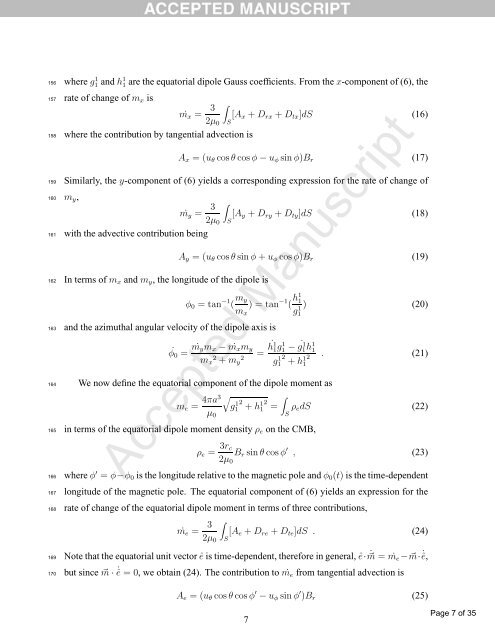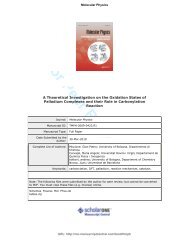Accepted Manuscript - TARA
Accepted Manuscript - TARA
Accepted Manuscript - TARA
You also want an ePaper? Increase the reach of your titles
YUMPU automatically turns print PDFs into web optimized ePapers that Google loves.
where g1 1 and h1 1 are the equatorial dipole Gauss coefficients. From the x-component of (6), the<br />
156<br />
rate of change of m x is<br />
157<br />
158<br />
159<br />
160<br />
161<br />
162<br />
163<br />
164<br />
165<br />
166<br />
167<br />
168<br />
m˙<br />
x = 3 [A x + D rx + D tx ]dS (16)<br />
2µ 0<br />
∫S<br />
where the contribution by tangential advection is<br />
A x = (u θ cosθ cosφ − u φ sin φ)B r (17)<br />
Similarly, the y-component of (6) yields a corresponding expression for the rate of change of<br />
m y ,<br />
m˙<br />
y = 3<br />
with the advective contribution being<br />
2µ 0<br />
∫S<br />
In terms of m x and m y , the longitude of the dipole is<br />
and the azimuthal angular velocity of the dipole axis is<br />
[A y + D ry + D ty ]dS (18)<br />
A y = (u θ cosθ sin φ + u φ cosφ)B r (19)<br />
φ 0 = tan −1 ( m y<br />
) = tan −1 ( h1 1<br />
) (20)<br />
m x<br />
<strong>Accepted</strong> <strong>Manuscript</strong><br />
g 1 1<br />
φ˙<br />
0 = m˙<br />
ym x − m˙<br />
x m y h˙<br />
1<br />
=<br />
1g1 1 − g ˙ 1h 1 1 1<br />
m x2 + m<br />
2 y g 12 1 + h 1 2<br />
. (21)<br />
1<br />
We now define the equatorial component of the dipole moment as<br />
m e = 4πa3 √ ∫<br />
g 12 1 + h 1 12 = ρ e dS (22)<br />
µ 0 S<br />
in terms of the equatorial dipole moment density ρ e on the CMB,<br />
ρ e = 3r c<br />
2µ 0<br />
B r sin θ cosφ ′ , (23)<br />
where φ ′ = φ−φ 0 is the longitude relative to the magnetic pole and φ 0 (t) is the time-dependent<br />
longitude of the magnetic pole. The equatorial component of (6) yields an expression for the<br />
rate of change of the equatorial dipole moment in terms of three contributions,<br />
m˙<br />
e = 3 [A e + D re + D te ]dS . (24)<br />
2µ 0<br />
∫S<br />
169<br />
170<br />
Note that the equatorial unit vector ê is time-dependent, therefore in general, ê· ˙⃗m = m˙<br />
e − ⃗m· ˙ê,<br />
but since ⃗m · ˙ê = 0, we obtain (24). The contribution to m˙<br />
e from tangential advection is<br />
A e = (u θ cos θ cos φ ′ − u φ sin φ ′ )B r (25)<br />
7<br />
Page 7 of 35
















